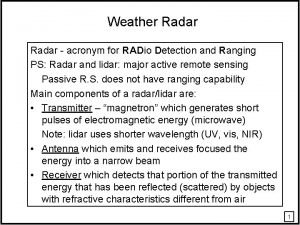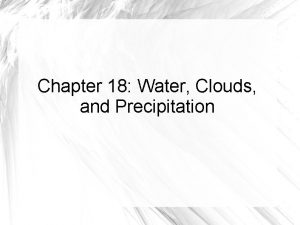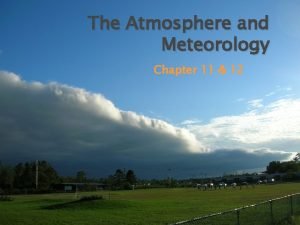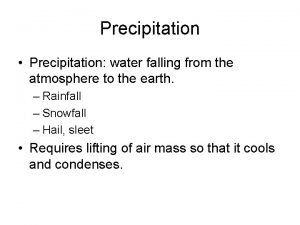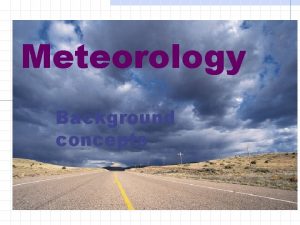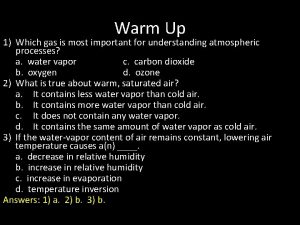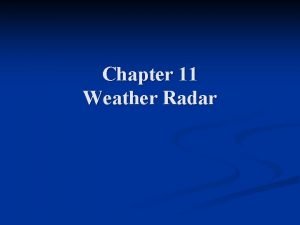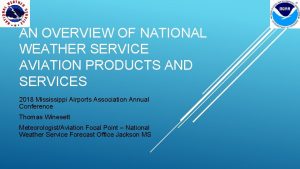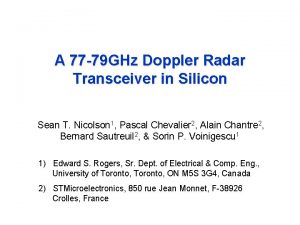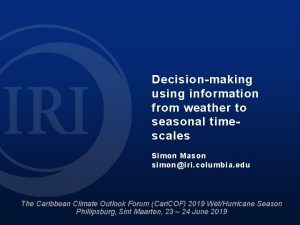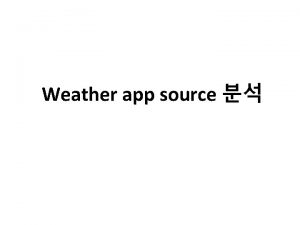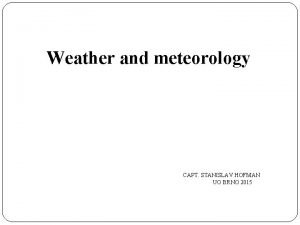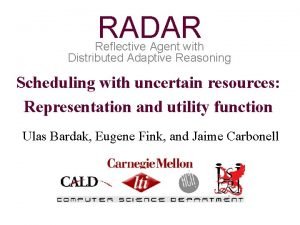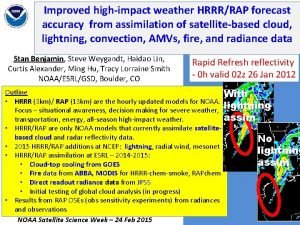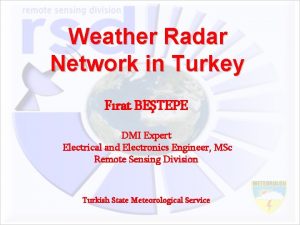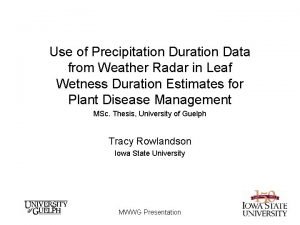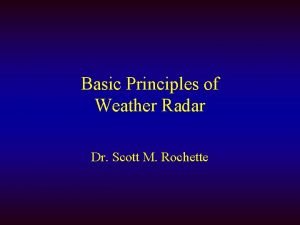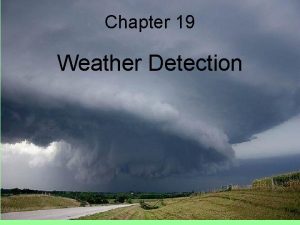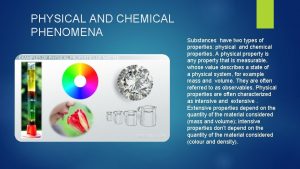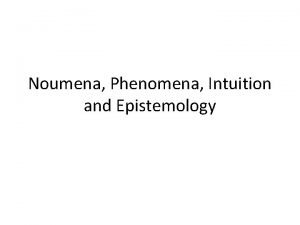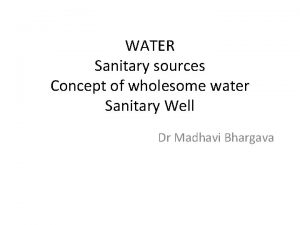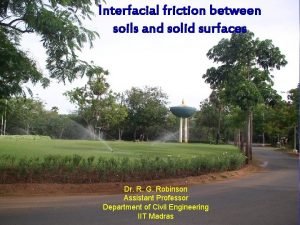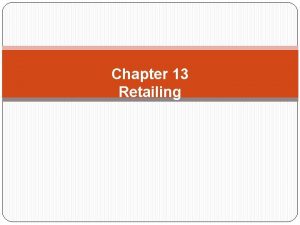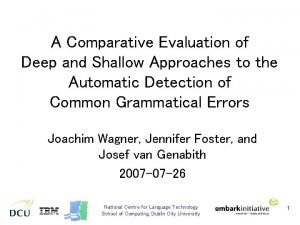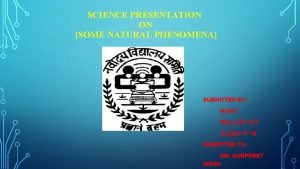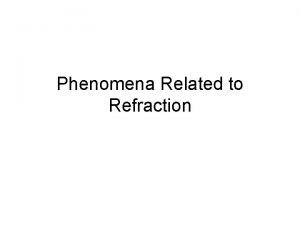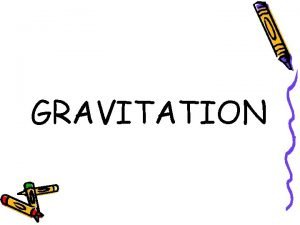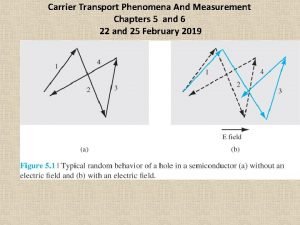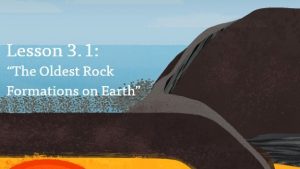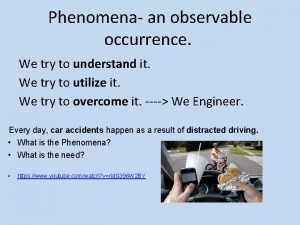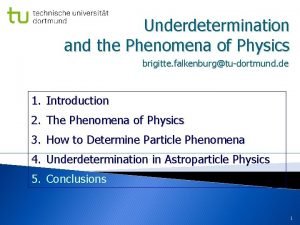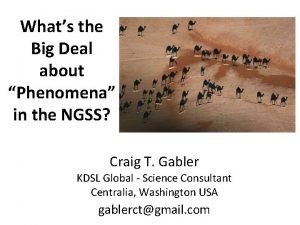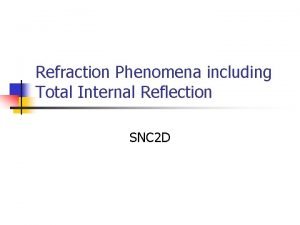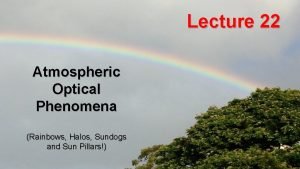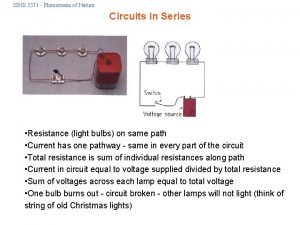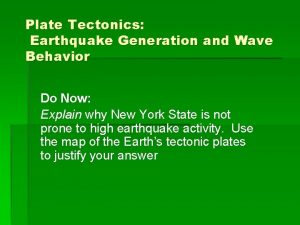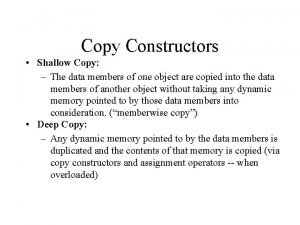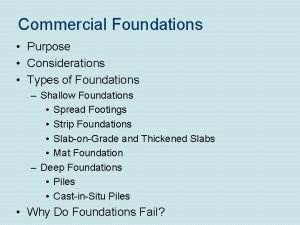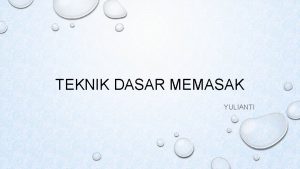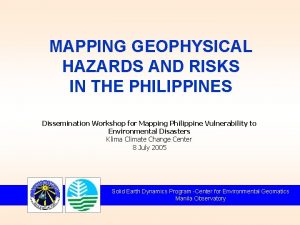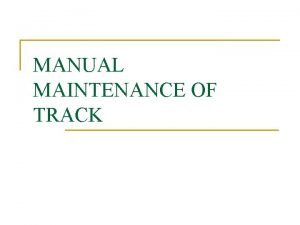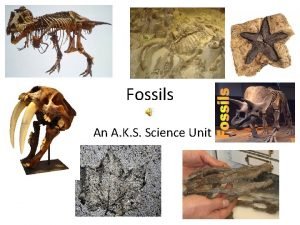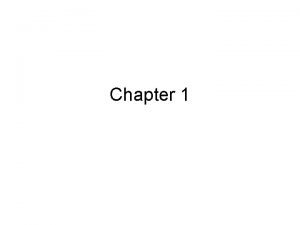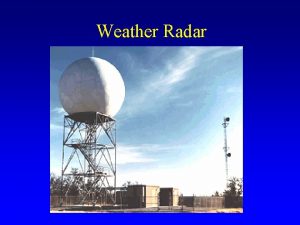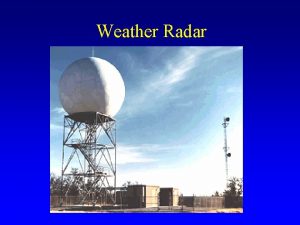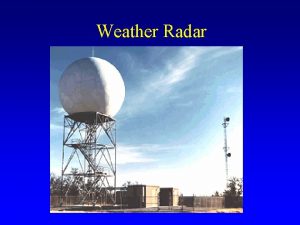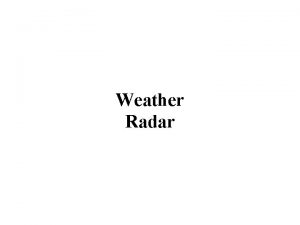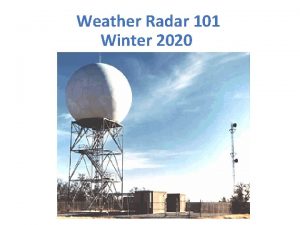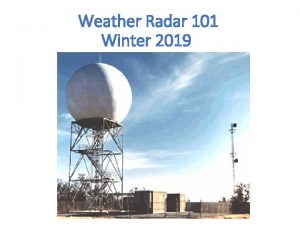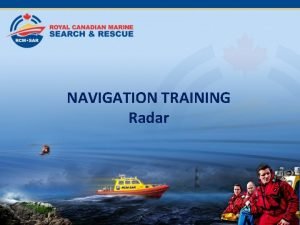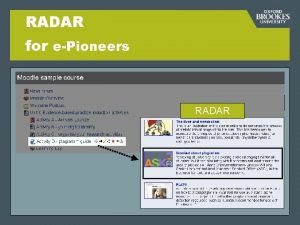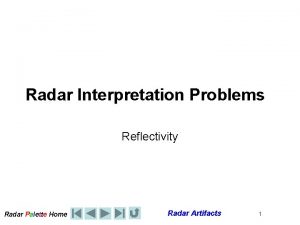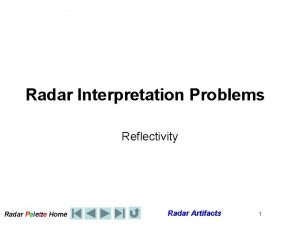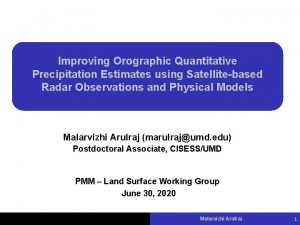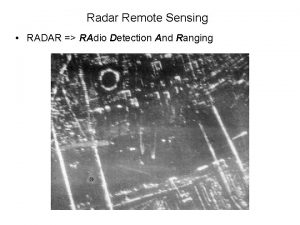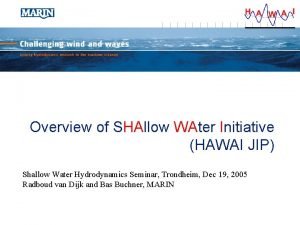Radar Detection of Shallow Weather and Orographic Phenomena










![Minimum Detectable Signal Reflectivity [d. BZ] The detection threshold (as a function of range). Minimum Detectable Signal Reflectivity [d. BZ] The detection threshold (as a function of range).](https://slidetodoc.com/presentation_image_h/912c3b1bf930fbbc22871d515c210e66/image-11.jpg)


![Homework Question Echo Power Size [microns or mm] Average Intensity [mm/h, cm/h] Or Liquid Homework Question Echo Power Size [microns or mm] Average Intensity [mm/h, cm/h] Or Liquid](https://slidetodoc.com/presentation_image_h/912c3b1bf930fbbc22871d515c210e66/image-14.jpg)



































































- Slides: 81

Radar Detection of Shallow Weather and Orographic Phenomena Paul Joe MSC Basic Radar 20100404

Module Objective 1. This module briefly explores “radar meteorology” issues of low level weather detection in a generic way. 2. Radar meteorology in complex terrain

Outline • Some “back of envelope calculations” of key elements – Typical reflectivities of rain, drizzle, fog, snow (detection issue) – Beam height (detection issue) – Beam width (quantitative and detection issues) – Sensitivity (detection issue) • Meteorology – Drizzle – Lake Effect Snow – Orographic Precipitation

Low Level Phenomena Detectable by Radar • Meteorological Targets – Precipitation (Rain, Snow, Hail, Drizzle) – Lake Breezes, Convergence Lines, Gust fronts, cold pools – Index of Refraction/Humidity – Turbulence (Bragg scattering) • Ground Clutter (not discussed here) – Building, Mountains, Forests • Hard Targets (not discussed here) – Wind turbines, Cars, ships, airplanes, space debris • Biological Targets (not discussed here) – Insects, birds, bats • Electro-magnetic Targets (not discussed here) – Other radars, RLANs, Sun, second trip echoes • Other – Forest fires – Sea Clutter Romanian Gust Front

General Comments – Low Scanning • Wide variety of phenomena and intensity of targets – Turbulence (too weak) to Mountains (very intense) – From very weak to very strong (-30 d. BZ to 95 d. BZ) • Different Doppler signatures – Some have 0 velocity – Some have aliased velocity (> Nyquist) • Advanced uses of weather radar – VDRAS – variational doppler radar assimilation system – Refractivity retrieval – use of ground clutter echoes • Quantitative Precipitation Estimation – Need low level scanning – Accurate at ranges < 80 -100 km • Commonality – Limited range! – Low echo strength (generally), Low height of weather, radar sensitivity is an issue

Drizzle Some Radar Examples

Germany Example 1 Drizzle in surface observations BUT NO/Little RADAR DATA Drizzle reported in surface observations but no radar echoes. Lang, DWD

Germany Example 2 Drizzle (mm/h) and very few echoes Lang, DWD

Drizzle in Finland! 1. Why was drizzle observed in Finland but not Germany? 2. Why is the drizzle observed only around the radar? 3. Why is the reflectivity pattern stronger near the radar and decreases away from the radar? 4. Why is there a range limit to see drizzle? Saltikoff, FMI

Minimum Detectable Signal Concept
![Minimum Detectable Signal Reflectivity d BZ The detection threshold as a function of range Minimum Detectable Signal Reflectivity [d. BZ] The detection threshold (as a function of range).](https://slidetodoc.com/presentation_image_h/912c3b1bf930fbbc22871d515c210e66/image-11.jpg)
Minimum Detectable Signal Reflectivity [d. BZ] The detection threshold (as a function of range). Probability Distribution of Reflectivity with Range (not important for this discussion). Function of Wx. The Radar Equation P=CZ r 2 Minimum Detectable Signal (constant power) Range [km] MDS can expressed as a noise temperature or a power measurement but for meteorologist it more useful to express as reflectivity at a particular range. Typically, -1 d. BZ at 50 km.

Some Radar Considerations P=CZ r 2 P = power, C = radar constant, r = range Z = N D 6 [Z] = mm 6/m-3 d. BZ = 10 log Z Reflectivity Factor - Linear

Radar Equation and MDS – Radar Equation accounts for expanding beam with range (1 /r 2) • Sensitivity (or MDS) is a certain power level – Just above the noise (hsssssss) level – In terms of P (power), it is a constant – In terms of Z (reflectivity), it is a function of range (1 /r 2) • A limitation for long range detection of weak echoes is the radar sensitivity! – If the reflectivity of the target is below MDS then the radar does not detect it! – Beware of artificial MDS! MDS The display of the radar data may be thresholded! Some data may not be displayed! Range Reflectivy • The Radar measures “P” – power received • The Radar Equation converts P to Z for a given range (r) Power Pmin = C Zmin(r) r 2 Range
![Homework Question Echo Power Size microns or mm Average Intensity mmh cmh Or Liquid Homework Question Echo Power Size [microns or mm] Average Intensity [mm/h, cm/h] Or Liquid](https://slidetodoc.com/presentation_image_h/912c3b1bf930fbbc22871d515c210e66/image-14.jpg)
Homework Question Echo Power Size [microns or mm] Average Intensity [mm/h, cm/h] Or Liquid Water Content [g/m 3] Number of particles in a cubic meter Calculate Z [mm 6/m 3] Leave this empty if you wish. Calculate d. BZ Leave this empty if you wish. Fog 0. 01 mm . 1 g/m^3 1 x 10^8 0. 0001 -40 Drizzle 0. 1 mm . 1 g/m^3 1 x 10^5 0. 1 -10 Rain 1 mm/h 100 20

A Drizzle Calculation Radius of a drizzle drop ~= 100 microns Rainrate of drizzle ~= 1 mm/h Fall speed ~= 1 cm/s Therefore, Number of drops ~= 28, 000 m^-3 Reflectivity ~= -5 d. BZ Can your radar see drizzle? How far can you see drizzle from the radar?

So, how far can you see drizzle (-5 d. BZ)? Or anything else? P=CZ r 2 -5 d. BZ ~ 25 km Minimum Detectable Signal (power)

Can you see drizzle – part 2? The Artificial MDS Situation 7 d. BZ Data in this shaded area is thresholded (not displayed)! ~ 25 km Typical Drizzle reflectivity

Reflectivity vs Range for Constant Power (1/r 2) Typical Radars Where does your radar fit on this diagram?

Survey Question about your Radars? How well do you know your radars? What is the minimum value that you have seen on your radar and at what range? d. BZ Rainrate 20 d. BZ 0. 5 mm/h 15 d. BZ 0. 3 10 d. BZ 0. 16 5 d. BZ 0. 08 0 d. BZ 0. 03 20 km 50 km 100 km 150 km Put a check in as many boxes as you want! Are you limited by an artificial MDS?

Beam Propagation Re-visited

Beamheight Considerations

Overshoot Key Concept! Beam totally overshoots the weather beyond this range! No detection at all! 0. 5 o Non-uniform beamfilling Shallow Weather The weather is detected but the beam is not filled beyond this range, so reflectivities are quantitatively underestimated from this range and beyond Note: the lower the beam the longer the range for detection ability!

Note: Colour scales are different! Drizzle d. BZ 1 km d. BZ ZDR Drizzle is round! Drizzle is due to warm rain process. Slow growth which results in small drops (0. 1 mm, 1 mm/h) Saltikoff, FMI

Survey: How well do you know your radars? What is the lowest elevation angle of your radars? Minimum Elevation Angle -0. 5 -0. 3 0. 0 0. 3 0. 5 Please put a check mark in this column

Summary: Drizzle in Finland! 1. Why was drizzle observed in Finland but not Germany? Thresholded! 2. Why is the drizzle observed only around the radar? Sensitivity 3. Why is the reflectivity pattern stronger near the radar and decreases away from the radar? Beamfilling 4. Why is there a range limit to see drizzle? ~80 -100 km, function of sensitivity, beamfilling, depth of the drizzle! Saltikoff, FMI

Germany Example 3 5 -6°C zle z i r D Hamburg , , Unusual widespread drizzle from cloud echoes aloft. At surface only few echoes above 1 d. BZ. Note: change in threshold for DWD, see more drizzle! Lang, DWD

Major Factors for Detection • Radar Sensitivity – Target Reflectivity/Radar MDS combination • Overshoot – Lowest Angle of Radar/Height of weather / Earth Curvature combination • Beam filling (quantitative) – Weather is too shallow or too low – Beam is very broad • Thresholding – Artificial MDS = Minimum Displayed Signal*

FOG Can the radar see fog?

Fog Non-operational Special Cloud/Fog Radar (35 GHz or Ka Band) d. BZ 10 km Fog has drop sizes from 10 to 30 microns, so very low reflectivities. An operational radar has a sensitivity as -8 d. BZ at 50 km. What is the controlling factor of detecting for this radar? - Sensitivity? or elevation angle? Or Artificial MDS (color table? ) Drop Size Distributions

Snow

Beamheight Again Quantitative measurements (Advanced Material)

Partial Beam Filling Range bins that are partially beamfilled, decreasing reflectivity with 0. 5 degree range!

Question: What do you think the reflectivity will look as a function of range? 0. 5 o Non-uniform beamfilling Shallow Weather d. BZ Range

Vertical Profile of Snow Function of Range 1. Snow originates aloft but grows as it falls. 2. The same vertical profile as observed by radar at increasing range due to beam filling, beam broadening (smoothing) and Earth curvature (can’t see lowest levels)!

Quantitative Impact of Beamfilling Note the fall off of values with range. This is NOT attenuation to which this is commonly attributed. It is a beam filling effect! Michelson, SMHI

Impact of Beamwidth / Beamfilling 30 day Accumulation 1. 0 o (blue) 0. 65 o (no blue) Example of the impact of beamwidth or beamfilling on quantitative precipitation estimation. One radar is 0. 65 o and the rest are 1. 1 o beamwidth radars. Smaller beamwidth means less beamfilling problems with range and farther quantitative reflectivity information. Patrick, EC

Applying the Correction aka Vertical Profile Correction aka Range Correction Koistinen, FMI

Orographic

Mountain Top Radars Germann, MCH

Freezing Level and Mountain Sited Radars Time-Height Temperature Freezing Level from Radiosondes Most of the time, the radar sees snow! July 2008 Payerne March 2008 Payerne

Valley Radar Pemberton Winter Olympic Park Blackcomb Whistler Mtn H 99 Squamish

Distance Range to Terrain VVO Whistler Elevation Angle Callaghan Squamish Whistler Callaghan Squamish Snow Azimuth North East South West North

Whistler Doppler Weather Radar

Another View Dave Murray Downhill Start VVO

What is this? Would you see it on a mountain top radar?

Blocked flow (downslope winds) means Intense precipitation is on the slope and not on mountain peak Precipitation: the intense precipitation is on the slope. Doppler velocity: Blue means air is moving to the left or downslope

How many low level jets do you see? Do you see convergence?

Remember RABT = Red Away Blue Toward (except in Switzerland)

Why is there a hole in the data? Would you see this on a mountain top radar?

Summary • Shallow Weather – Focus on drizzle as an example to explain detectability and measurability – Observability is a function of the radar too (MDS, beamheight, beamwidth) – A few simple but key calculations to explain (not calibration, not attenuation) – A little insight into “radar meteorology” • A few case examples – Drizzle, snow, lake effect snow, orographic

Examples of Shallow Weather

Lake Effect Snow shallow but lots of weather 1/8 SM +SN +BLSN Patrick, EC

Morphology of Snowbands Thermal Convergence - Single Band Development

Morphology of Snowbands Frictional Convergence - Single Band Development

Ocean/Lake Effect Snow Conceptual Model Niziol, NWS/COMET

Fetch Length of time cold air is over warm water. Note that small variations in wind direction can result in significant changes in fetch. On Lake Erie for instance, a 230 degree wind has a 130 -km fetch, while a 250 degree wind results in a 360 -km fetch!

Morphology of Snow Bands Horizontal Roll Multiple Banding The direction of the wind will produce significantly different results from lake to lake depending on the shape and orientation of a body of water. Single Band Land Breeze Banding Meso. Low Multi-Lake Banding

Ocean/Lake Effect Snow Lake Superior Multiple Bands Georgian Bay Lake Huron Lake Ontario Lake Michigan Single Band Lake Erie Frictional Convergence


Morphology of Snow Bands Multiple Band - Horizontal Roll Convection • Counter-rotating vortices in the boundary layer. • Major axes aligned with the mean boundary layer wind shear vector. • Wavelength (updraft to updraft) is about three times the height of the Boundary Layer.

Lake effect snow wind from northwest

Velocity Structure d. BZ Low speeds in the middle of the band indicating low horizontal speeds or convergence Vr

Separated Bands d. BZ Vr

Thermal Convergence

The Meso. Low Light Winds

Lake Breeze and Convective Weather

Lake Breeze Boundaries Lake Huron Lake Ontario Lake St Clair Lake Erie Morning Mid Afternoon “Pure” LB example Enhance convergence

Lake Breezes + = Pure lake breeze + Moderate SW Flow

Spring (15 Mar - 15 Jun) Tornado Touchdown Points … overlaid with boundaries from 31 July 1994. . . Forecasters use knowledge of lake breeze positions in their severe weather forecast for weak tornadoes … and enhanced in regions where lake breeze boundaries often form. … tornadoes are suppressed in regions where Southwest winds are onshore. . .

Extremely Shallow Case 3. 5 1. 5 -0. 1

Orographic Precipitation Rain shadow

Two Conceptual Models of Orographic Precipitation Medina and Houze, 2003

Stable Case: Blocked Flow from South Precipitation on plains, Italy Flow is blocked, flow is towards the south ALPS MAP IOP-8 North South Medina and Houze, 2003

Radial Velocity - Blocked Flow Medina and Houze, 2003

Unstable Case: Up and Over Precipitation is on the first range No blocked flow. Flow is from the south Medina and Houze, 2003

Radial Velocity – Up and Over Medina and Houze, 2003

Lee Side Suppression H 3 km ain FOE or N, n H The Alps

Accumulations 1 h accumulation N ge ir eb ain r o rey g , zg ns i a Er nt ain r u mo No e Or n ai or N Doppler

Wind Drives Precipitation Germann, MCH


 Lake effect
Lake effect Mti versus pulse doppler radar
Mti versus pulse doppler radar Mti vs pulse doppler radar
Mti vs pulse doppler radar Radar is an acronym for radio detection and
Radar is an acronym for radio detection and Orographic precipitation
Orographic precipitation Frontal wedging
Frontal wedging In orographic lifting clouds form when moist winds
In orographic lifting clouds form when moist winds Orographic lifting definition
Orographic lifting definition Orographic rainfall
Orographic rainfall Orographic lifting
Orographic lifting Munich weather radar
Munich weather radar Nn radar
Nn radar Awc weather radar
Awc weather radar Weather radar transceiver
Weather radar transceiver Olney weather radar
Olney weather radar Yahoo weather rss feed
Yahoo weather rss feed Cirrocus
Cirrocus Cbr weather radar
Cbr weather radar Rap weather radar
Rap weather radar Dmiradar
Dmiradar Elora weather radar
Elora weather radar Scott afb weather radar
Scott afb weather radar Lightening radar
Lightening radar Physical and chemical phenomena
Physical and chemical phenomena Colloids examples
Colloids examples Importance of interfacial phenomena in pharmacy
Importance of interfacial phenomena in pharmacy Noumenal
Noumenal Wholesome water definition
Wholesome water definition Shallow and deep foundation
Shallow and deep foundation Surface shallow and deep culture
Surface shallow and deep culture Shallow comparative and superlative
Shallow comparative and superlative Narrow and shallow assortment example
Narrow and shallow assortment example Shallow comparative and superlative
Shallow comparative and superlative Weather station model weather symbols
Weather station model weather symbols Tongue twisters weather
Tongue twisters weather Clothes poem
Clothes poem Weather sunny rainy cloudy windy stormy
Weather sunny rainy cloudy windy stormy Whether the weather be fine
Whether the weather be fine Heavy weather by weather report
Heavy weather by weather report Capital weather gang weather wall
Capital weather gang weather wall A moose monikko
A moose monikko Some natural phenomena class 8 ppt
Some natural phenomena class 8 ppt Phenomena related to refraction
Phenomena related to refraction Observable phenomena psychology
Observable phenomena psychology Contemporary phenomenon examples
Contemporary phenomenon examples Natural language processing
Natural language processing Reference phenomenon in nlp
Reference phenomenon in nlp Gravitational phenomena
Gravitational phenomena Carrier transport phenomena
Carrier transport phenomena Anchor phenomena
Anchor phenomena Observable phenomena meaning
Observable phenomena meaning Reoulox phenomena
Reoulox phenomena Global climate phenomena
Global climate phenomena Random phenomena
Random phenomena Sinusoidal functions as mathematical models
Sinusoidal functions as mathematical models What is the meaning of phenomena
What is the meaning of phenomena Slide todoc.com
Slide todoc.com Noumena vs phenomena
Noumena vs phenomena Noumena vs phenomena
Noumena vs phenomena Total internal reflection
Total internal reflection A rainbow is an optical display of color
A rainbow is an optical display of color Noumena vs phenomena
Noumena vs phenomena Shallow processing definition
Shallow processing definition Shallow focus earthquake
Shallow focus earthquake Introduction to semiconductor manufacturing technology
Introduction to semiconductor manufacturing technology Headlands
Headlands Shallow trench isolation
Shallow trench isolation Shallow heap
Shallow heap Copy constructor
Copy constructor Purpose of foundation in building
Purpose of foundation in building Shallow latch vs deep latch
Shallow latch vs deep latch Apa itu menyetup
Apa itu menyetup Pad foundation section
Pad foundation section Basilan at romblon tsunami
Basilan at romblon tsunami Beater packing
Beater packing Shallow frying equipment
Shallow frying equipment Shallow print or mark in solid rock
Shallow print or mark in solid rock How do you cook a pot of rice using the shallow pan method
How do you cook a pot of rice using the shallow pan method Shallow trench isolation
Shallow trench isolation Example of shallow processing
Example of shallow processing Nexplanon too shallow
Nexplanon too shallow Contoh shallow knowledge dan deep knowledge
Contoh shallow knowledge dan deep knowledge



